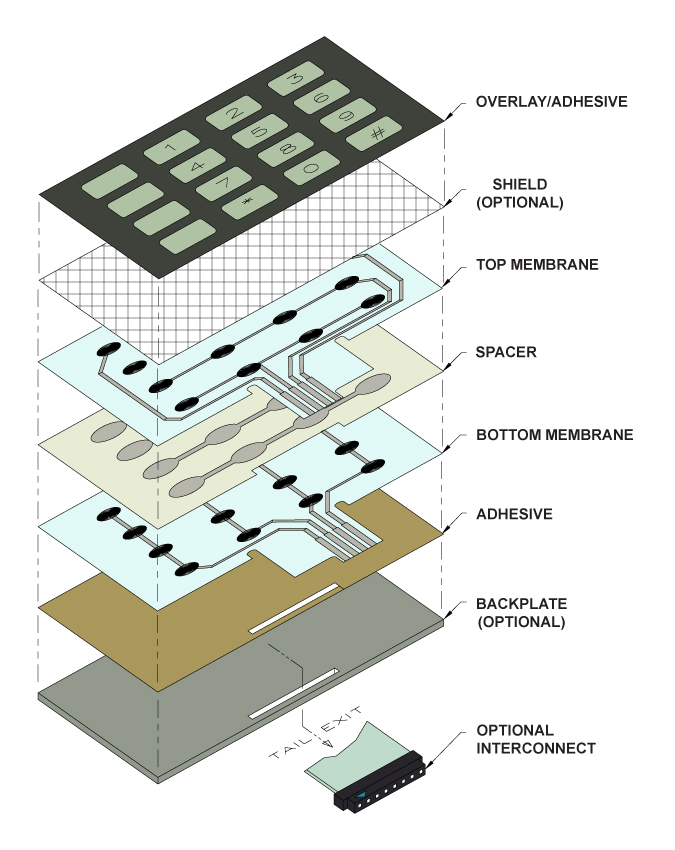Discover Just How a Membrane Switch Enhances Toughness and Capability in Tools
Discover Just How a Membrane Switch Enhances Toughness and Capability in Tools
Blog Article
Understanding the Capability of Membrane Switches Over for Interface Tools
The functionality of membrane switches over represents a significant development in interface style, incorporating efficiency with visual flexibility. These switches run through a multi-layered framework that equates customer interactions into electric signals, permitting both portable layouts and resilience against ecological factors. As sectors increasingly focus on customer experience, comprehending the nuances of membrane switch innovation ends up being essential. What ramifications do these improvements hold for future applications, and just how might they redefine customer interactions throughout different gadgets?
What Are Membrane Switches?
Membrane layer buttons are cutting-edge user interface devices that facilitate customer interaction with digital tools. These functional elements include numerous layers, consisting of a visuals overlay, spacer, and a published circuit layer. The style permits for a smooth assimilation right into various digital gadgets, improving both the visual and useful elements of interface.
Membrane buttons are generally used in a large range of applications, from home home appliances to industrial machinery and clinical gadgets. Their building and construction commonly includes a slim profile, making them a perfect choice for small designs. The responsive feedback provided by these switches can be crafted to meet details individual choices, making certain reliable interaction between the user and the device.
Longevity is an additional considerable advantage of membrane switches, as they are immune to dust, dampness, and chemicals, which improves their life expectancy in demanding environments. In addition, these buttons can be personalized in regards to shape, size, and graphic style, permitting branding and user-specific features. On the whole, membrane switches over represent a useful remedy for enhancing individual experience in digital devices, integrating functionality with visual allure in an effective manner.
Exactly How Membrane Layer Switches Work
Operating on a simple concept, membrane layer changes utilize a split construction to register user input efficiently. Each button contains several layers, including a printed circuit layer, a spacer layer, and a top graphic layer, which are developed to interact flawlessly. When an individual presses the top layer, it presses the spacer layer, bringing the conductive aspects of the circuit layer right into contact with each various other.
This call creates a shut circuit, signaling the gadget to execute a details function. The style enables various setups, consisting of responsive responses, which can boost the customer experience by giving a physical feeling upon activation. The products utilized in membrane layer buttons usually include flexible substrates, such as polyester or polycarbonate, which make certain sturdiness and durability against deterioration.

Trick Benefits of Membrane Layer Buttons

An additional considerable advantage is their density. Membrane buttons are thin and light-weight, which enables suppliers to save room in their gadgets without giving up functionality. This attribute is especially beneficial in applications where weight and volume are critical factors to consider.
Additionally, membrane layer switches are immune to dirt, wetness, and chemicals, improving their durability. This strength prolongs their life-span and decreases the demand for frequent replacements, causing cost financial savings gradually.
Moreover, the responsive feedback offered by membrane layer switches can be maximized to improve customer interaction. They can consist of functions such as elevated switches or distinct clicks, enhancing usability and customer experience.
Applications Across Industries
Interface devices using membrane layer buttons are widespread in a broad variety of sectors, showcasing their adaptability and functionality. Membrane Switch. In the medical sector, membrane layer buttons are integral to devices such as diagnostic devices and client monitoring systems, where their durability and convenience of cleansing are crucial for maintaining health criteria. In a similar way, in the auto industry, these buttons are used in dashboard controls and infotainment systems, supplying a sleek and contemporary interface for individuals.
In addition, the consumer electronics sector gain from membrane switches in home appliances and portable tools, where small style and easy to use interfaces improve user experience. Industrial applications also utilize membrane layer changes for control panels in machinery and automation systems, emphasizing their robustness and resistance to rough settings.
In the aerospace and defense industries, membrane buttons are utilized in cabin controls and devices, where reliability and performance under extreme problems are vital. Additionally, the check over here pc gaming sector progressively integrates membrane switches in controllers and gallery devices, contributing to an interesting user experience. On the whole, the flexibility of membrane switches allows their widespread usage throughout various markets, emphasizing review their value in contemporary interface layout.
Future Fads in Membrane Switch Over Technology

Additionally, using innovative products, such as polycarbonate and polyester films, is expected to increase, giving enhanced longevity and resistance to environmental stressors. These materials add to the total longevity of membrane switches, making them appropriate for harsher commercial applications.
Moreover, the consolidation of wise modern technology, consisting of IoT connection, will certainly make it possible for membrane layer buttons to communicate with other devices and systems, promoting a more interactive user experience. This trend aligns with the expanding need for smart devices across different sectors, from health care to customer electronic devices.
Last but not least, modification alternatives are prepared for to increase, permitting manufacturers to produce bespoke remedies customized to certain customer demands and choices. These growths will certainly place membrane layer switches as vital elements in the development Related Site of individual interface innovation.
Final Thought
In final thought, membrane switches represent an essential advancement in user interface innovation, offering a reputable and versatile remedy for diverse digital applications. As improvements in material scientific research and touch sensing technologies continue, the performance and applicability of membrane layer switches are anticipated to increase, strengthening their significance in modern digital tools.
Report this page